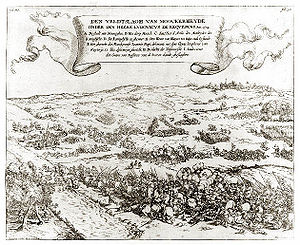- Battle of Mookerheyde
-
Battle of Mookerheyde Part of the Eighty Years' War 
Date 14 April 1574 Location Mook en Middelaar, Limburg
(present-day the Netherlands)Result Decisive Spanish victory Belligerents  Dutch Rebels
Dutch Rebels
German mercenaries Spain
SpainCommanders and leaders  Louis of Nassau †
Louis of Nassau †
 Henry of Nassau †
Henry of Nassau † Sancho d'Avila
Sancho d'Avila
 Bernardino de Mendoza
Bernardino de MendozaStrength 5,500 infantry
2,600 cavalry5,000 infantry
800 cavalryCasualties and losses 3,000 dead or wounded 150 dead or wounded Oosterweel – Dahlen – Heiligerlee – Groningen – Jemmingen – Jodoigne – Brielle – Goes – Mechelen (1572) – Zutphen (1572) – Naarden – Haarlem – Flushing – Borsele – Haarlemmermeer – Zuiderzee – Namur – Alkmaar – Leiden – Reimerswaal – Mookerheyde – Buren – Zierikzee – Aalst - Maastricht (1576) - Antwerp (1576) - Gembloux – Rijmenam – 1st Deventer – Maastricht (1579) – Mechelen (1580) - Hardenberg – 1st Breda – Dunkirk – Antwerp (1584-85) – Empel – Boksum – Zutphen (1586) – 1st Bergen op Zoom – Gravelines – Medemblik – Spain – Geertruidenberg – 2nd Breda – 2nd Deventer – 2nd Groenlo – Turnhout – 3rd Groenlo – 2nd Bredevoort – Doetinchem – Nieuwpoort – Ostend – Sluys – Lingen – 4th Groenlo – Gibraltar – Playa-Honda – 2nd Gibraltar – Jülich – 2nd Bergen op Zoom – 3rd Breda – Bahia – Puerto Rico – 5th Groenlo – Bay of Matanzas – 's-Hertogenbosch – Albrolhos – Bruges – Slaak – Maastricht (1632) – Saint Martin – Leuven – Schenkenschans – Lizard Point – 4th Breda – Venlo – Kallo – Geldern – English Channel – The Downs – Providencia – 1st Hulst – Cape St. Vincent – 2nd Saint Martin – 2nd Hulst – La Naval de Manila – Puerto de CaviteThe Battle of Mookerheyde was a battle of the Eighty Years' War fought on 14 April 1574 near the village Mook and the river Meuse. In the winter months of on 1574, William the Silent's brothers, Louis and Henry of Nassau, raised a mercenary army in Germany of 6500 infantry and 3000 cavalry, and led them towards the city of Maastricht, where they were to met the Prince of Orange named William the Silent who lead 6000 Dutchmen himself. After that, they would join forces and march for the relief of Leiden which was besieged by a large Spanish force under the Duke of Alba. Along the march over a thousand men deserted, seven hundred were killed in a night attack by the Spanish, and the rest were mutinous for their pay, which they had not received due to the Prince's empty coffers.
Finally, after crossing the Meuse River, before having joined armies with William the Prince of Orange, Count Louis with only 5,500 infantry and 2,600 cavalry encountered Alba who had temporarily lifted the Siege of Leiden and marched with 5,000 infantry and 800 cavalry to oppose Louis' march. This army was led by Sancho d'Avila and Bernardino de Mendoza. Near the village of Mook, the two armies met. At first, the cavalry of the Dutch triumphed over the Spanish cavalry, and the Dutch infantry fired several salvos into the Spanish ranks, but the Spanish infantry were well-trained and in time defeated their adversaries.
In the end, the Dutch suffered a disasterly defeat, losing at least 4,000 men with both Louis and Henry killed. Soon after, the rebel army dispersed due to lack of pay.
Then, Alba resumed the siege of Leiden, which finally terminated in the Dutch favour.
Categories:- 1574 in Europe
- Conflicts in 1574
- Battles of the Eighty Years' War
- Limburg (Netherlands)
Wikimedia Foundation. 2010.
